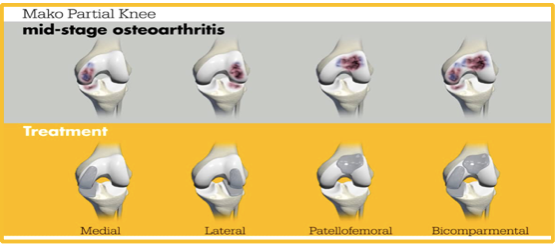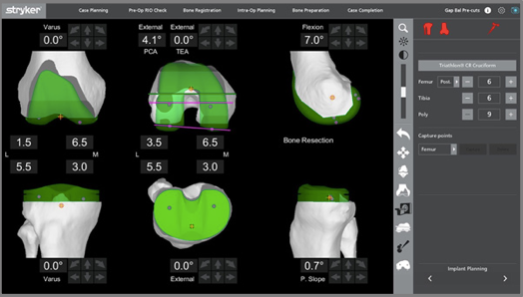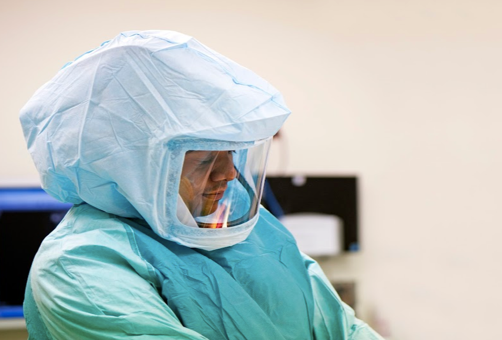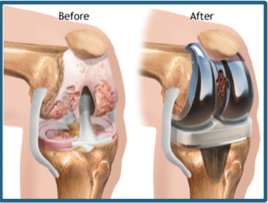Robotic Assisted Partial and Total Knee Replacement
Dr Agolley has been using the Mako Orthopaedic Robot for Total and Partial Knee Replacement surgery on the Gold Coast since its introduction to Australia in 2017. He is an experienced and accomplished orthopaedic surgeon committed to staying at the forefront of surgical and non-surgical advances in orthopaedics for best patient care and best patient outcomes. He has completed hundreds of robotic assisted Total and Partial Knee Replacements for patients.
To book an appointment, do not hesitate to
contact us at either of Dr Agolley's Tugun or Southport clinics.
What is Robotic assisted Knee Replacement Surgery?
Robotic knee replacement surgery (total and partial) involves the use of robotic technology to assist the surgeon in performing knee replacement with increased accuracy. Robotic surgical assistant systems such as Mako, create a personalised surgical plan based on your unique anatomy.
The Mako orthopaedic robot applies cutting edge technology to total and partial knee replacement that is designed to provide better outcomes for patients. Published research has shown increased accuracy and precision of bone cuts and implant placement with the use of Mako for both partial and total knee replacement surgery.1 The use of robotics has also been shown to increase protection of the soft tissues around the knee, potentially improving recovery times.
2
Depending on the amount of arthritis you have, Dr Agolley may discuss with you the option of a total or partial knee replacement. Total knee replacement is common for widespread arthritis in your knee. If you only have arthritis in a small part of your knee, you may be a candidate for partial knee resurfacing which is a shorter and quicker pain-relieving procedure if your knee is appropriate for it.
To learn more, please contact Dr Agolley's friendly staff for more information.
What is the Difference between total and partial knee replacement?
Partial knee replacement, also known as uni-compartmental knee replacement, involves replacing only the damaged part of the knee joint.

The Inner (medial), outer (lateral), front (patellofemoral) parts can all be replaced individually depending on your pattern of arthritis. Partial replacements often take less surgery time, are less painful and have a shorter recovery time before you are back to your active lifestyle.3 Ask Dr Agolley if this procedure may be appropriate for you.
Total knee replacement involves replacing the entire knee joint with an artificial implant. A robotic assisted total knee replacement is the gold-standard procedure for widespread advanced arthritis of the knee. It may be the better procedure for long term pain relief and better outcomes in patients with wide-spread arthritis in their knee. Discuss with Dr Agolley, which type of knee replacement is right for you.
What is involved in Robotic Knee Replacement surgery?
You will be required to have a CT scan of your damaged knee joint. This scan is uploaded to the Mako software which creates a detailed 3D image of your unique joint anatomy. Dr Agolley uses this model to pre- plan the surgery in fine detail, determining the optimal size, placement, and alignment of the implant unique to you.

The patients’ bony anatomy is registered during the operation which allows matching of the implant to the patients’ personal anatomy.

In the operating room Dr Agolley will remove the damaged surfaces of the arthritic knee joint assisted by the Mako robotic arm. The advanced technology of the Mako robot allows the surgeon to remain within the boundaries set out by your pre-operative plan, ensuring precise bone cuts and more accurate placement and alignment of your knee implant.
During Mako robotic surgery the surgeon retains complete control and can make any necessary adjustments. The robotic arm does not perform the surgery itself nor can it make decisions on its own or move in any way without the surgeon guiding it. It is designed to support the orthopaedic surgeons skill and knowledge, not replace it.

Why Consider Robotic Knee Replacement Surgery?
There are a multitude of benefits for using robotic surgical assistants in total and partial knee replacement surgery:
Improved Precision:
The robotic system provides real-time data and feedback, allowing for precise adjustments, precise cuts and accurate implant placement leading to more predictable outcomes.
Personalised Surgery:
Pre-operative planning software creates a 3D model of your knee, enabling a customised approach tailored to your specific needs optimising outcomes.
Less Tissue Damage: The robots precision ensures the preservation of as much of the healthy tissue and bone as possible, an advantage if revision surgery is ever needed.
A recently published research study showed that compared to conventional knee replacements patients having robotic surgery had improved outcomes with less pain, less pain medication, less need for physiotherapy and better knee bend when leaving hospital. Improving patients’ satisfaction levels and recovery times for total knee replacement surgery.4
More information is available on the Stryker MAKO Orthopaedic Robot website.
Considerations
Robotic partial and total knee replacements are a common surgical procedure with generally favourable outcomes, but like any major surgery, it carries some risks. It is important to discuss all potential risks and benefits with your orthopaedic surgeon.
Patient Centred Care
Robotic partial and total knee replacement surgery provides life-changing benefits for patients and can help people enjoy greater mobility and return to many of the activities they used to enjoy.
We hope this information helps you understand the benefits and process of robotic total knee replacement surgery. Our goal is to ensure you feel informed and confident about your treatment options. Dr Agolley will assess your condition and provide individual advice to help you determine if Robotic Knee replacement surgery is right for you. If you have any questions or would like to schedule a consultation with Dr Agolley, please contact our office. Our team is here to support and provide you with the highest quality care.
References
1. Robotic-Arm Assisted Total Knee Arthroplasty Demonstrated Accuracy To Plan Even During Learning Phase Hampp E., Scholl L., Prieto M., Chang T., Abbasi A., Bhowmik-Stoker M., Otto J., Jacofsky D.J., Mont M.A. European Knee Society Arthroplasty Congress 2017, London, UK, 20 & 21 April 2017
2. Improved Accuracy of Component Positioning with Robotic-Assisted Uni-compartmental Knee Arthroplasty, Stuart W. Bell, Iain Anthony, Bryn Jones, Angus MacLean, Philip Rowe, Mark Blyth. J Bone Joint Surg Am Apr 2016, 98 (8) 627-635; DOI: 10.2106/JBJS.15.00664
3. Patient relevant outcomes of unicompartmental versus total knee replacement: systematic review and meta-analysis HannahWilson, Rob Middleton, Simon G F Abram, Stephanie Smith, Abtin Alvanms, William Jackson, Nicholas Bottomley,Sally Hopewell, Andrew J Price BMJ 2019; 364 doi: https://doi.org/10.1136/bmj.l352 (Published 21 February 2019)
4. Kayani B, Konan S, Tahmassebi J, Rowan FE, Haddad FS. An assessment of early functional rehabilitation and hospital discharge in conventional versus robotic-arm assisted unicompartmental knee arthroplasty: a prospective cohort study. Bone Joint J. 2019 Jan;101-B(1):24-33. doi: 10.1302/0301-620X.101B1.BJJ-2018-0564.R2. PMID: 30601042.


